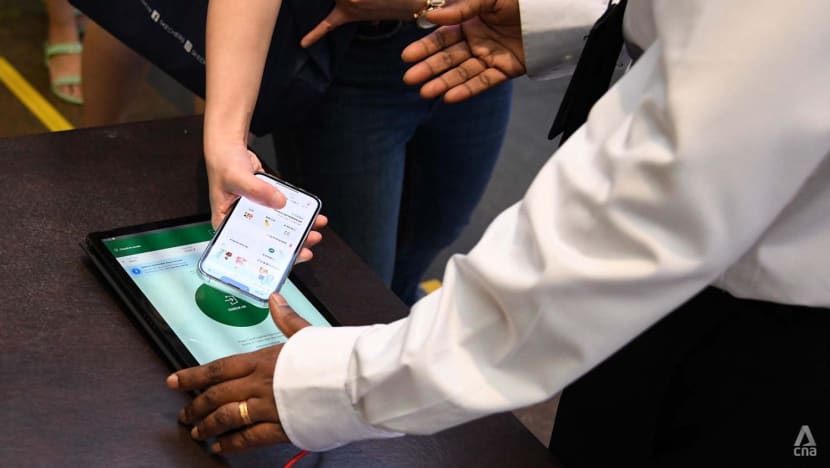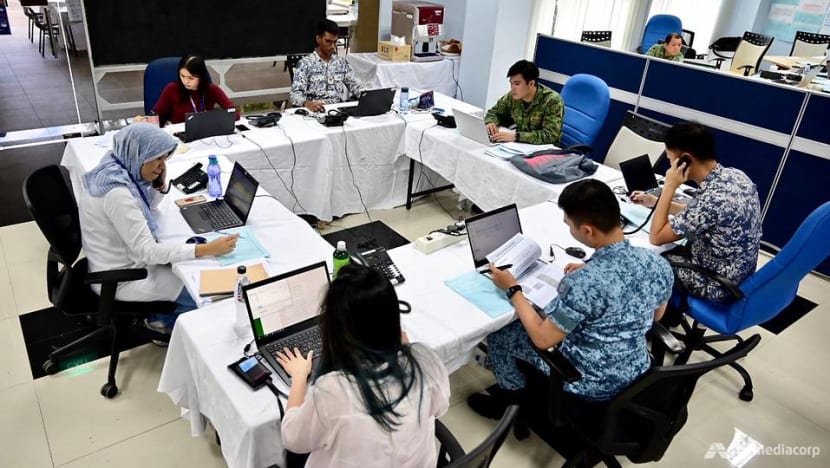Commentary: TraceTogether and SafeEntry shouldn’t be needed for entry into malls and low-risk areas
If TraceTogether’s only role for most people in Singapore is to indicate vaccination status, then it should stop being mandated for entry to malls, says NUS Saw Swee Hock School of Public Health’s Alex Cook.

A woman checks into a shopping mall on Oct 20, 2021, the first day of the end of the grace period for vaccination-differentiated measures in Singapore. (Photo: Calvin Oh/CNA)
SINGAPORE: As a European living in Singapore, I’ve found myself preoccupied several times over the last two years with this question: Why are deaths rates in my old home 15 times higher than in my new one?
One might chalk it up to a generic stricter response in Singapore. But the data says otherwise: The Oxford government response tracker shows that people in the United Kingdom, France and Germany have spent more time in lockdown and out of school than Singapore.
I’ve reached the conclusion that, more specifically, it’s the comprehensiveness of Singapore’s testing, contact tracing, isolation and quarantine that lies behind this gulf between the pandemic’s impact here and in other high-income countries.
Until recently, authorities took a “blunderbuss” approach to contact tracing, aggressively tracing and quarantining to ringfence infections and clusters. All COVID-19 cases were isolated in healthcare facilities. This reduced the transmissibility of the virus substantially.
Looking at the data, we found secondary attack rates in American households to be about three times higher than in Singapore, meaning an infected person was far less likely to infect family members here. Identifying and isolating cases quickly has protected our families while slowing the epidemic growth.
ABOUT TIME CONTACT TRACING WAS STEPPED DOWN
Despite the important contribution it has made so far, I believe it is time to further step down contact tracing, now that there is high vaccine coverage in Singapore and the vaccinated run a much lower risk of severe COVID-19.
Contact tracing is part of a quartet, alongside testing, isolation and quarantine. Remove one element and the ensemble falls apart.
Without testing, whose contacts do we trace? Without isolation of cases, why quarantine their contacts? Without quarantining contacts, what is the point of doing contact tracing to find them?

So, it made sense when the Ministry of Health (MOH) simplified protocols in October after the expansion of the Home Recovery Programme, substantially reducing the strictness of quarantine for close contacts.
Now, contrast this to earlier in the pandemic, when close contacts were aggressively traced and subject to close monitoring in dedicated quarantine facilities for a fortnight.
Today, a more targeted ring of close contacts are identified to undergo just a week of self-monitoring and can leave home so long as they test negative on an antigen test.
We could pare this back even further, by ceasing the interactions close contacts have with MOH: Being told you are a contact and uploading the first antigen test result.
It’s hard to see why either is actually necessary, since most close contacts – within a family, workplace or known social gatherings – will likely know or be informed by the case that they’ve been exposed.
MASSIVE UNSEEN COSTS OF CONTACT TRACING
Contact tracing can sound deceptively simple, with callers interviewing cases and piecing their activities using technologies with a light footprint. But it is not without cost.
Imagine the one to two thousand cases reported daily currently and assume each with a dozen contacts to sort and inform. It’s easy to see how this rapidly becomes a mammoth undertaking and the manpower needed to follow up on cases. In August, there were almost 500 contact tracers hard at work.
There are also labour costs for businesses to man entrances to check customers correctly use TraceTogether and SafeEntry.
The value of extensive contact tracing information has also diminished. Earlier in the pandemic when cases were few, knowing where infection clusters had developed meant the public could make an informed choice to monitor their health for possible exposure or even shop elsewhere.
How will new variants affect us? Listen to two professors weigh in on CNA's Heart of the Matter:
Today, you can’t proactively reduce your risk of exposure in the same way. As MOH’s geospatial data shows, cases are now all over the country—not unexpected when there are 10,000 diagnosed cases every week.
It seems the main benefit of continuing using TraceTogether now is to certify our vaccination statuses and enforce vaccination-differentiated measures on the 4 per cent of unvaccinated adults and teens, and no longer for contact tracing purposes.
ROLE OF CONTACT TRACING IN ENDEMIC STATE?
Contact tracing will remain imperative in targeted settings like hospitals and nursing homes where there are more vulnerable people. Missing infections there could prove deadly, as even vaccinated patients or residents are at risk of severe outcomes if they get infected.
Some healthcare settings, such as the National Centre for Infectious Diseases, have specialised tracking systems for patients and healthcare workers that use radio-frequency identification tags, rather than Bluetooth in TraceTogether.
This technology is specifically designed for the task of identifying patients who have come into contact with a case and is ideal for high-risk settings like hospitals. In time, such technologies could become commonplace in other hospitals.
But until then, TraceTogether may have some use in controlling hospital outbreaks and could be retained for patients, staff and visitors.
However, in the general community, with the high levels of infection now and expected to rise alongside further relaxations of restrictions, we can all expect to be exposed to the virus at some point.
In a more endemic state, contact tracing can no longer offer much value except in certain high-risk settings.
Since TraceTogether’s only role for most people in Singapore is to indicate vaccination status, it should stop being mandated for entry to malls, because there are other ways to do that. Instead, we could use TraceTogether as one of several means to show vaccination status, alongside paper certificates or the HealthHub app.
Many people will probably keep using TraceTogether, simply as an efficient way to show they’re vaccinated. But if TraceTogether or SafeEntry check-ins don’t lead to action by the authorities for most cases, they shouldn’t be necessary.
And seeing as 96 per cent of the eligible population are vaccinated, perhaps the authorities should reassess whether the costs of checking every single customer’s vaccination status merit the additional protection afforded.
KEEPING OUR CAPABILITIES READY
COVID-19 is the second pandemic I’ve experienced in Singapore. In the early days of H1N1 in 2009, I recall well when contact tracing was a manual affair and could only be sustained a month or two before the authorities had to give up.
That we’ve been able to push contact tracing to its full potential for almost two years of COVID-19 is testament both to the pioneering technologies and hard work of the many civil servants involved.
One lesson from the COVID-19 pandemic has been that with thorough testing, tracing, isolation and quarantine, we may be able to contain a pandemic long enough to roll out vaccination to almost all the population and save untold lives.
When Disease X – the hypothetical catastrophic viral threat – hits, or if a variant of SARS-CoV-2 emerges that requires a complete reboot of our approach, SafeEntry and TraceTogether should be part of our response from day one.
The challenge will be in keeping our capabilities ready to be activated or scaled up rapidly when needed – such as if the Omicron variant turns out to be severe enough to force the country back into containment mode.
Until then, with vaccination rates as high as they now are, it is time to give the contact tracers a well-earned rest.
Associate Professor Alex Cook is Vice Dean (Research) and Domain Leader (Biostatistics and Modelling) at the Saw Swee Hock School of Public Health, National University of Singapore.




















